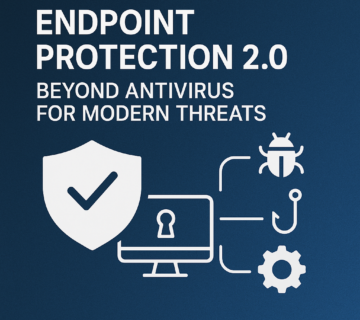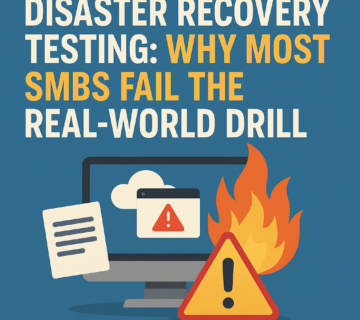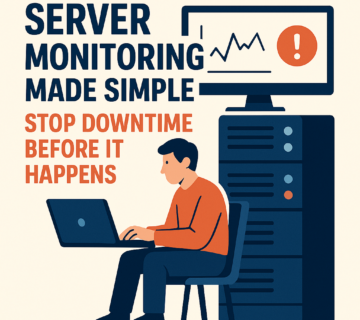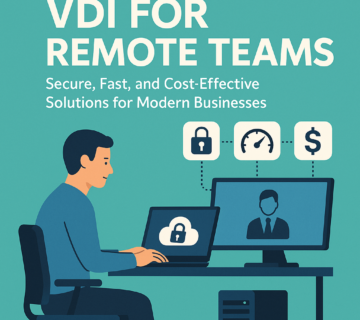Disaster Recovery Drill: How to Run a 90-Minute Tabletop That Actually Works
🎙️ Dive Deeper with Our Podcast!
90-Minute Disaster Recovery Tabletop Exercise Guide
👉 Listen to the Episode: https://technijian.com/podcast/90-minute-disaster-recovery-tabletop-exercise-guide/
Subscribe: Youtube | Spotify | Amazon
Introduction
When disaster strikes, you don’t want to discover that your disaster recovery plan is just expensive shelf-ware. Yet 73% of organizations admit they’re not adequately prepared for disaster recovery, and many have never actually tested their plans in a realistic scenario.
The good news? You don’t need to shut down operations for days or invest in costly full-scale drills to validate your disaster recovery strategy. A well-structured 90-minute tabletop exercise can reveal critical gaps in your plan, test team readiness, and ensure your Recovery Time Objective (RTO) and Recovery Point Objective (RPO) are achievable—not just theoretical.
This guide walks you through Technijian’s battle-tested approach to disaster recovery tabletop exercises that deliver real results without disrupting your business.
Why Traditional DR Testing Fails (And What Works Instead)
The Problem with “Set It and Forget It” DR Plans
Most disaster recovery plans suffer from three critical flaws:
- They’re never tested – Plans gather dust in SharePoint folders while assumptions go unchallenged
- Tests are too complex – Full-scale disaster simulations are expensive, time-consuming, and disruptive
- No clear metrics – Without measuring RTO and RPO during tests, you’re flying blind when real disasters occur
The 90-Minute Tabletop Solution
A tabletop exercise is a discussion-based session where team members walk through disaster scenarios without actually taking systems offline. When done correctly, these exercises:
- Validate your recovery procedures in a low-risk environment
- Identify gaps in documentation, communication, and technical processes
- Measure realistic RTO/RPO against your business requirements
- Build muscle memory so teams respond instinctively during real incidents
- Cost a fraction of full-scale disaster recovery tests
The key is structure. A 90-minute window forces focus on what matters most while respecting everyone’s time.
Understanding RTO and RPO: The Metrics That Matter
Before diving into the tabletop exercise, let’s clarify the two most critical disaster recovery metrics:
Recovery Time Objective (RTO)
RTO is the maximum acceptable time your systems can be down before the business suffers unacceptable consequences.
Example: If your e-commerce platform has a 4-hour RTO, you need to restore online ordering capabilities within 4 hours of an outage.
Recovery Point Objective (RPO)
RPO is the maximum acceptable amount of data loss measured in time. It determines how frequently you need to back up your data.
Example: If your financial database has a 1-hour RPO, you can’t lose more than 1 hour of transaction data, meaning you need at minimum hourly backups.
Why These Metrics Must Drive Your DR Drill
Your tabletop exercise isn’t complete until you’ve tested whether your actual recovery procedures can meet your stated RTO and RPO targets. Many organizations discover during drills that their 2-hour RTO is actually a 12-hour process when all the real-world steps are counted.
The 90-Minute Tabletop Framework: Step-by-Step
Pre-Drill Preparation (1 Week Before)
1. Define Your Scenario (15 minutes)
Choose a realistic disaster scenario relevant to your infrastructure:
- Ransomware attack encrypting critical file servers
- Data center failure due to natural disaster
- Cloud provider outage affecting primary services
- Cyber attack compromising production databases
- Human error causing data deletion or corruption
Pro Tip: Rotate scenarios quarterly to test different aspects of your DR plan.
2. Identify Key Participants (10 minutes)
Your tabletop exercise needs the right people in the room:
- IT leadership (CIO/CTO or IT Director)
- Systems administrators responsible for affected systems
- Backup/DR specialist who manages recovery tools
- Key business stakeholders who understand operational impact
- Communications lead for stakeholder updates
- Facilitator to guide the exercise (ideally external for objectivity)
Recommended team size: 6-10 people. Too few and you miss critical perspectives; too many and the exercise becomes unmanageable.
3. Prepare Exercise Materials (30 minutes)
Gather and distribute these materials before the drill:
- Current disaster recovery plan documentation
- Network diagrams and system dependencies
- Backup schedules and retention policies
- Contact lists and escalation procedures
- RTO/RPO targets for each critical system
- Access credentials and recovery tools (in secure format)
The 90-Minute Exercise Timeline
Minutes 0-10: Scenario Introduction and Ground Rules
Facilitator Actions:
- Welcome participants and explain the exercise purpose
- Present the disaster scenario with specific details
- Establish ground rules: no phones, focus on process not blame, take notes
- Clarify that systems stay operational—this is discussion-based
Example Scenario Presentation: “It’s Tuesday at 9:30 AM. Your monitoring system has alerted that all domain controllers are unreachable. Initial investigation suggests ransomware has encrypted your primary and secondary domain controllers. The last clean backup was completed at 2 AM today. The ransomware has been in your environment for 48 hours based on security logs. Walk me through your response.”
Minutes 10-25: Initial Response and Assessment
Key Questions to Address:
- Who discovers the incident? How do they escalate?
- Who makes the decision to declare a disaster and activate the DR plan?
- What’s the immediate priority? Containment? Assessment? Communication?
- Which systems are affected? What’s the ripple effect on dependent systems?
- What’s the estimated downtime if we proceed with recovery?
Facilitator Role: Probe for specifics. “You said you’d call the IT manager—what’s their number? What if they don’t answer?” Surface hidden assumptions.
Metrics to Track:
- Time from detection to DR plan activation
- Completeness of initial assessment
- Clarity of roles and responsibilities
Minutes 25-45: Recovery Process Walkthrough
Step Through Each Recovery Phase:
- Backup Verification
- Where are backups stored? How do you access them?
- Who has access credentials?
- How do you verify backup integrity?
- Time estimate: _____
- Infrastructure Preparation
- Do you need to provision new servers/VMs?
- Are failover systems already in standby mode?
- What network changes are required?
- Time estimate: _____
- Data Restoration
- What’s the restore order for interdependent systems?
- How long does each system take to restore?
- Who performs each restore operation?
- Time estimate: _____
- Testing and Validation
- How do you verify systems are functional?
- What testing must occur before bringing users back?
- Who approves the return to production?
- Time estimate: _____
Critical Exercise: Add up all the time estimates. Does the total exceed your RTO? This is where many organizations discover their RTO targets are unrealistic.
Minutes 45-60: RTO/RPO Reality Check
Calculate Actual vs. Target Metrics:
Create a visible chart comparing:
| System | Target RTO | Actual RTO (Drill) | Target RPO | Actual RPO (Drill) | Gap |
| Domain Controllers | 4 hours | 7 hours | 8 hours | 8 hours | -3 hours RTO |
| File Servers | 8 hours | 6 hours | 4 hours | 4 hours | +2 hours RTO |
| Email System | 2 hours | 9 hours | 1 hour | 12 hours | -7 hours RTO, -11 hours RPO |
Discussion Points:
- Which gaps are acceptable vs. critical?
- What would we need to change to meet targets?
- Are our targets realistic for our budget and infrastructure?
This reality check often reveals that organizations need either:
- Better backup technology
- More frequent backup schedules
- Additional failover infrastructure
- Revised (more realistic) RTO/RPO targets
- Better documentation and training
Minutes 60-75: Communication and Stakeholder Management
Map the Communication Plan:
- Internal Communications
- Who updates the CEO/executive team?
- How do you notify all employees?
- What’s the update cadence during recovery?
- External Communications
- Customer notification process and messaging
- Vendor/partner communications
- Regulatory notifications (if required)
- Media handling (if necessary)
- Documentation During Recovery
- Who’s responsible for incident logging?
- How do you track recovery progress?
- What documentation supports potential insurance claims?
Exercise: Draft a sample stakeholder communication in real-time. Is the messaging clear? Appropriate? Timely?
Minutes 75-85: Identify Gaps and Capture Action Items
Facilitator leads structured gap analysis:
Common Gaps Discovered:
- Documentation Issues
- Outdated runbooks
- Missing credentials
- Unclear procedures
- Incorrect contact information
- Technical Issues
- Backups not tested for restore
- Insufficient bandwidth for large restores
- Missing dependencies or licenses
- Inadequate failover capacity
- Process Issues
- Unclear decision-making authority
- Missing escalation procedures
- No communication templates
- Untrained team members
- Timing Issues
- RTO/RPO gaps
- Unrealistic expectations
- Serial processes that could be parallel
- Waiting for approvals during critical windows
Action Items Must Be SMART:
- Specific: “Update the file server restore runbook to include the new backup location”
- Measurable: “Test restore of 500GB file server backup”
- Assignable: Name a specific person responsible
- Realistic: Can be completed with available resources
- Time-bound: Set a completion deadline
Minutes 85-90: Wrap-Up and Next Steps
Facilitator Summary:
- Recap major findings
- Highlight what worked well
- Emphasize critical gaps requiring immediate attention
- Confirm action item owners and deadlines
- Schedule follow-up review meeting
- Set date for next tabletop exercise (recommend quarterly)
Distribute:
- Exercise report template for completion
- Action item tracker
- Lessons learned document
Measuring Success: What Good Looks Like
A successful 90-minute tabletop exercise should deliver:
Immediate Outcomes
- Documented RTO/RPO gaps with realistic timelines for each system
- 10-20 specific action items assigned to individuals with deadlines
- Increased team confidence in disaster response capabilities
- Identified documentation gaps that need updating
Long-Term Benefits
- Reduced actual recovery time when real disasters occur
- Faster decision-making during high-stress incidents
- Better budget justification for DR infrastructure investments
- Compliance evidence for regulatory requirements
- Lower insurance premiums (some carriers offer discounts for documented DR testing)
Red Flags That Your Exercise Needs Improvement
- Everyone agrees everything would work perfectly
- No action items are identified
- Discussion stays theoretical without getting into specifics
- Facilitator has to provide all the answers
- Time estimates aren’t challenged or validated
- Technical experts aren’t present or engaged
Common Tabletop Exercise Mistakes (And How to Avoid Them)
Mistake #1: Making It Too Easy
Problem: Choosing an unrealistic or overly simple scenario that doesn’t test your actual vulnerabilities.
Solution: Base scenarios on real incidents that have affected similar organizations. Add complications like “your backup admin is on vacation” or “the vendor support line has a 4-hour wait time.”
Mistake #2: Skipping the Technical Details
Problem: Staying at a high level without getting into the actual commands, steps, and procedures.
Solution: Ask “show me” questions. Have participants pull up actual documentation or walk through exact steps they’d take.
Mistake #3: Forgetting About Dependencies
Problem: Testing systems in isolation without considering ripple effects.
Solution: Map dependencies before the exercise. When one system goes down, cascade the impact to everything that relies on it.
Mistake #4: No Follow-Through on Action Items
Problem: Creating a great list of improvements that never get implemented.
Solution: Schedule a 30-day follow-up meeting to review action item progress. Make DR drill preparation part of someone’s job description.
Mistake #5: Only Testing Once
Problem: Running one tabletop exercise and considering DR testing “complete.”
Solution: Schedule quarterly tabletop exercises with different scenarios. Rotate participants to ensure knowledge transfer. Run an unannounced exercise annually.
Advanced Tabletop Techniques
Inject Cards for Realism
During the exercise, introduce unexpected complications:
- “The backup you’re trying to restore is corrupted. What now?”
- “Your cloud provider just extended their ETA for recovery by 6 hours.”
- “A reporter is calling for comment on the outage.”
- “The ransomware has spread to your backup servers.”
These injects test adaptability and reveal whether teams can think beyond the documented plan.
Time Pressure Simulation
Set a visible countdown timer that matches your RTO. When time expires, calculate:
- Estimated revenue lost
- Number of customers affected
- Regulatory penalties incurred
- Reputation damage
This adds healthy pressure and demonstrates real business impact.
Cross-Functional Participation
Invite representatives from:
- Finance (to discuss financial impact)
- Legal (to discuss regulatory and liability issues)
- HR (to discuss employee communications)
- Sales/Customer Service (to discuss customer impact)
Disasters affect more than just IT—your exercise should too.
Creating Your 90-Day DR Improvement Cycle
Your first tabletop exercise is just the beginning. Implement this continuous improvement cycle:
Month 1: Fix Critical Gaps
- Update outdated documentation
- Test backup restores
- Implement quick wins from action items
Month 2: Enhance Capabilities
- Improve backup frequency for systems missing RPO
- Add failover capacity for systems missing RTO
- Train team members on procedures
Month 3: Validate Improvements
- Run another tabletop exercise with a different scenario
- Measure improvement in RTO/RPO capabilities
- Identify new gaps and prioritize
Repeat Quarterly
Each cycle should show measurable improvement in:
- Time to recovery (RTO achievement)
- Data protection (RPO achievement)
- Team confidence and execution
- Documentation completeness
Real-World Example: Tabletop Exercise in Action
The Scenario
A healthcare billing company with 200 employees ran their first 90-minute tabletop exercise testing ransomware response.
What They Discovered
RTO Gap: Their stated 4-hour RTO for the billing system was actually a 14-hour process when all steps were counted:
- Backup verification: 1 hour
- Server provisioning: 3 hours (no hot standby)
- Database restore: 6 hours (500GB over limited bandwidth)
- Application configuration: 2 hours
- Testing: 2 hours
RPO Gap: Daily backups meant potential loss of an entire day’s billing data, violating their 4-hour RPO target.
Communication Gap: No pre-approved customer notification templates. Legal review would add 2+ hours.
Authority Gap: Unclear who could authorize spending $50,000 on emergency cloud resources during off-hours recovery.
The Improvements
Immediate (30 days):
- Implemented hourly transaction log backups (fixed RPO)
- Created pre-approved communication templates
- Documented spending authority matrix
- Updated contact lists
Short-term (90 days):
- Deployed hot standby billing server
- Upgraded backup infrastructure for faster restores
- Conducted team training on recovery procedures
Result: Second tabletop exercise showed 4.5-hour RTO—meeting their target with a small buffer.
Disaster Recovery Tabletop Exercise Checklist
Use this checklist to ensure your 90-minute exercise covers all critical elements:
Pre-Exercise (1 Week Before)
- Select realistic disaster scenario
- Identify and invite key participants
- Distribute DR plan documentation
- Reserve conference room and schedule time
- Prepare scenario details and inject cards
- Print network diagrams and system lists
- Set up time tracking mechanism
During Exercise (90 Minutes)
- Introduce scenario and ground rules (10 min)
- Walk through initial response (15 min)
- Detail recovery procedures (20 min)
- Calculate actual RTO/RPO (15 min)
- Review communication plan (15 min)
- Identify gaps and action items (10 min)
- Summarize findings and next steps (5 min)
Post-Exercise (Within 1 Week)
- Distribute exercise report to all participants
- Assign action items with deadlines
- Update DR plan based on findings
- Schedule 30-day follow-up meeting
- Document lessons learned
- Schedule next tabletop exercise
Frequently Asked Questions (FAQ)
How often should we run disaster recovery tabletop exercises?
Recommended frequency: Quarterly tabletop exercises with at least one unannounced exercise annually. Run additional exercises after major infrastructure changes, team changes, or when implementing new critical systems.
What’s the difference between a tabletop exercise and a full disaster recovery test?
A tabletop exercise is a discussion-based walkthrough of your DR plan without actually taking systems offline. It’s low-risk and tests people, processes, and documentation. A full DR test actually fails over to recovery systems and validates technical capabilities. Tabletop exercises should be done quarterly; full DR tests annually.
How do we know if our RTO and RPO targets are realistic?
Your tabletop exercise will reveal whether your targets are achievable. Add up the time required for each recovery step and compare to your RTO. Check backup frequency against your RPO. If there’s a gap, either improve your technology and processes, or adjust your targets to match business reality and available budget.
What if we discover our RTO/RPO targets are impossible to meet?
This is actually a successful outcome of the exercise. You now have data to either: (1) invest in better DR infrastructure to meet targets, or (2) work with business stakeholders to set more realistic targets. Most organizations discover their initial RTO/RPO targets were aspirational rather than achievable.
Should we include vendors and service providers in the exercise?
If critical systems depend on third-party vendors (cloud providers, MSPs, SaaS platforms), either include them in the exercise or at minimum verify their SLAs and escalation procedures. Many DR plans fail because of vendor dependencies that weren’t fully considered.
What size team is optimal for a 90-minute tabletop exercise?
Ideal range: 6-10 participants. You need enough people to cover all critical roles (IT, business stakeholders, communications) but not so many that the discussion becomes unmanageable. For larger organizations, consider running multiple exercises with different system owners.
How technical should the exercise be?
Very technical. The exercise should get into specific commands, actual procedures, and real timelines. If someone says “we’d restore from backup,” ask them to walk through the exact steps, identify where the backups are stored, and estimate how long each step takes. Superficial exercises don’t reveal real gaps.
What should we do with the action items after the exercise?
Create a tracking system with assigned owners and deadlines. Schedule a 30-day follow-up to review progress. Incomplete action items should have explanations and revised deadlines. Make DR improvement part of someone’s actual job responsibilities—not just an extra task.
Can we run a virtual tabletop exercise with remote teams?
Yes, virtual exercises work well with the right tools. Use video conferencing with screen sharing for documentation review. Consider using a virtual whiteboard for real-time tracking of timelines and action items. The 90-minute timeframe actually works better virtually than longer exercises that cause video fatigue.
What if we’ve never tested our disaster recovery plan before?
Your first tabletop exercise will likely reveal significant gaps—that’s normal and expected. Don’t let inexperience prevent you from starting. The exercise framework provided here will guide you through the process, and discovering gaps in a controlled exercise is far better than discovering them during a real disaster.
How do we measure the ROI of running disaster recovery drills?
Quantifiable benefits:
- Reduced downtime during actual incidents (measured in hours saved)
- Avoided data loss (measured in RPO improvement)
- Lower insurance premiums (some carriers offer 10-20% discounts)
- Compliance evidence (avoiding regulatory fines)
- Improved staff efficiency (faster response times)
Example: If your revenue is $1M per day and a tabletop exercise reduces recovery time by 4 hours (by identifying gaps), that’s $166K in avoided losses from your first incident.
Should we hire an external facilitator?
An external facilitator brings objectivity, experience from other organizations, and can ask challenging questions without internal politics. However, a knowledgeable internal facilitator can be effective if they have the authority to probe technical assumptions. Consider external facilitation for your first exercise and then transition to internal facilitation once you’ve established the process.
How Technijian Can Help
At Technijian, we understand that disaster recovery planning shouldn’t be a checkbox exercise—it needs to be a living, tested process that actually works when you need it most.
Our 90-Minute DR Tabletop Service
We’ve refined our disaster recovery tabletop methodology through hundreds of exercises across industries from healthcare to finance to manufacturing. Our facilitated 90-minute sessions deliver:
Structured Process: We guide your team through proven scenarios that reveal real gaps in your DR plan, with specific focus on validating your RTO and RPO targets against real-world recovery timelines.
Objective Assessment: As an external facilitator, we ask the tough questions your team might avoid and provide unbiased evaluation of your DR readiness without internal politics.
Actionable Deliverables: You’ll leave with a comprehensive report documenting RTO/RPO gaps, prioritized action items with realistic timelines, and a clear roadmap for improvement.
Industry Expertise: Our team brings real-world experience from actual disaster recovery events, not just theoretical knowledge, so we can spot risks specific to your industry and infrastructure.
Backup & Continuity Solutions
Beyond tabletop exercises, Technijian provides complete backup and disaster recovery solutions:
- Backup Architecture Review: Assessment of your current backup strategy against best practices
- RTO/RPO Optimization: Right-sizing your backup infrastructure to meet business requirements
- Disaster Recovery Planning: Comprehensive DR plan development with documented procedures
- Backup Technology Implementation: Deployment of modern backup solutions with verified restore capabilities
- Quarterly DR Drills: Ongoing tabletop exercises with different scenarios to ensure continuous readiness
- Full DR Testing: Annual full-scale disaster recovery tests that validate your technical recovery capabilities
Request Your DR Tabletop Playbook
Ready to test whether your disaster recovery plan actually works? Technijian offers a complimentary DR Tabletop Playbook that includes:
✓ Scenario templates for common disasters (ransomware, data center failure, cyber attack)
✓ RTO/RPO calculation worksheets
✓ Tabletop exercise facilitation guide
✓ Action item tracking templates
✓ Sample communication templates for stakeholders
✓ 90-minute exercise agenda and timeline
Request your playbook today and take the first step toward DR confidence. Our team will also provide a complimentary 30-minute consultation to discuss your specific disaster recovery challenges and objectives.
Why Organizations Choose Technijian
Proven Methodology: Our 90-minute tabletop framework has helped organizations across the country identify critical gaps before disasters occur, reducing actual recovery times by an average of 60%.
Real-World Experience: We’ve guided organizations through actual ransomware attacks, data center failures, and natural disasters—we know what works in high-pressure situations, not just in documentation.
Comprehensive Support: From initial planning through implementation and ongoing testing, we’re your partner in building disaster recovery resilience that protects your business.
Technology Agnostic: We work with your existing backup and DR infrastructure while providing objective recommendations for improvement based on your specific RTO/RPO requirements.
Conclusion: Don’t Wait for a Disaster to Test Your Plan
Every day you delay testing your disaster recovery plan is another day you’re operating on hope rather than proven capability. A 90-minute tabletop exercise is a small investment that can save your organization from catastrophic downtime, data loss, and reputation damage.
The difference between organizations that recover quickly from disasters and those that don’t isn’t luck—it’s preparation. Specifically, it’s preparation that’s been tested, refined, and validated through realistic exercises that expose gaps before they become crises.
Your disaster recovery plan is only as good as your team’s ability to execute it under pressure. The 90-minute tabletop exercise framework gives you a structured, efficient way to build that capability without disrupting operations or requiring massive investment.
The question isn’t whether you’ll face a disaster—it’s whether you’ll be ready when it happens.
Take Action Today
Download Technijian’s DR Tabletop Playbook and schedule your first 90-minute disaster recovery exercise. Within one quarter, you’ll have validated your RTO/RPO targets, identified and addressed critical gaps, and built the team confidence that makes the difference between recovery and catastrophe.
Request Your Free DR Tabletop Playbook →
Or contact Technijian directly to discuss facilitated disaster recovery exercises customized to your infrastructure, industry, and risk profile.
📞 Contact Technijian
Email: sales@technijian.com
Phone:949379499
Website: www.technijian.com
Technijian is a leading provider of backup and continuity solutions, helping organizations build and test disaster recovery capabilities that actually work when needed most.
About Technijian
Technijian is a premier Managed IT Services provider AI-powered workflow automation solutions, specializing in connecting enterprise communication and support platforms. With deep expertise in Microsoft Teams, 3CX, and major helpdesk systems, Technijian helps businesses transform fragmented tech stacks into cohesive, intelligent ecosystems that drive efficiency, improve customer satisfaction, and support scalable growth.
Specializing in delivering secure, scalable, and innovative AI and technology solutions across Orange County and Southern California. Founded in 2000 by Ravi Jain, what started as a one-man IT shop has evolved into a trusted technology partner with teams of engineers, AI specialists, and cybersecurity professionals both in the U.S. and internationally.
Headquartered in Irvine, we provide comprehensive cybersecurity solutions, IT support, AI implementation services, and cloud services throughout Orange County—from Aliso Viejo, Anaheim, Costa Mesa, and Fountain Valley to Newport Beach, Santa Ana, Tustin, and beyond. Our extensive experience with enterprise security deployments, combined with our deep understanding of local business needs, makes us the ideal partner for organizations seeking to implement security solutions that provide real protection.
We work closely with clients across diverse industries including healthcare, finance, law, retail, and professional services to design security strategies that reduce risk, enhance productivity, and maintain the highest protection standards. Our Irvine-based office remains our primary hub, delivering the personalized service and responsive support that businesses across Orange County have relied on for over two decades.
With expertise spanning cybersecurity, managed IT services, AI implementation, consulting, and cloud solutions, Technijian has become the go-to partner for small to medium businesses seeking reliable technology infrastructure and comprehensive security capabilities. Whether you need Cisco Umbrella deployment in Irvine, DNS security implementation in Santa Ana, or phishing prevention consulting in Anaheim, we deliver technology solutions that align with your business goals and security requirements.
Partner with Technijian and experience the difference of a local IT company that combines global security expertise with community-driven service. Our mission is to help businesses across Irvine, Orange County, and Southern California harness the power of advanced cybersecurity to stay protected, efficient, and competitive in today’s threat-filled digital world.





